California’s vast landscapes offer some of the most awesome stargazing opportunities. Yet, with so many options, finding the best dark sky locations can feel overwhelming, especially if you’re an amateur astronomer or astrophotography enthusiast eager to capture the night’s beauty.
While the allure of the night sky is undeniable, light pollution and a lack of knowledge about the Bortle Scale complicate the quest for the perfect stargazing spot. This makes it challenging to experience the full splendor of the Milky Way, nebula clusters, and bright stars like Sirius.
I guide you through the maze of choosing great places for stargazing in California. From understanding the Bortle Scale to highlighting the 23 fantastic sites to see twinkling stars, this article ensures you’re well-equipped to plan your own adventure and be ready to take a road trip filled with celestial wonders.
Key Things to Know:
- California offers 23 top-notch stargazing sites, each with unique dark sky qualities.
- Understanding the Bortle Scale is crucial for selecting the top stargazing locations.
- Light pollution maps help identify unbeatable spots for observing the night sky.
- Dark Sky Parks in California are designated for their minimal light pollution.
Recommended For You
Video Overview: Great Places to Stargaze in California
I’ve prepared a 5-minute video overview of the best stargazing in California to help save you time. The details in my video are covered in this article.
Best Places to see the Stars in California
Although I cover 23 locations (+1 bonus spot) in this article, I also wanted to give you my opinion of the first-class, best places to stargaze in California:
best places to stargaze in northern California
There are many places for stargazing Northern California. These are my top recommendations for northern California stargazing:
- Yosemite National Park
- Lake Tahoe
- Big Sur (just South of the San Francisco Bay Area)
The Top Places to Stargaze in Southern California
If you’re stargazing Southern California, then be sure to check out these recommendations:
Be sure to also check out my other Southern California articles:
FREE GOOGLE MAP OF The BEST PLACES to STARGAZE in California
I’ve put together a free Google Map of the 23 Best Places For Stargazing In California. It comes with everything you need to find the best place to see stars in California.
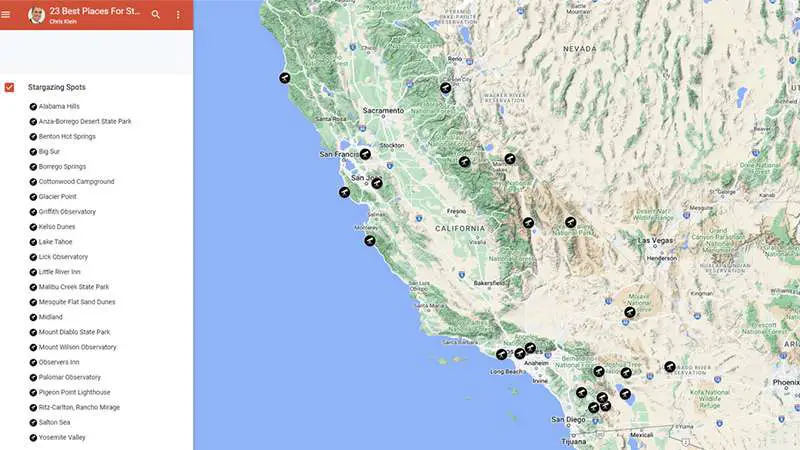
The locations covered on this map, and in detail in the article below, include the following:
- Alabama Hills
- Anza-Borrego Desert State Park
- Benton Hot Springs
- Big Sur
- Borrego Springs
- Cottonwood Campground: Joshua Tree National Park
- Glacier Point: Yosemite National Park
- Griffith Observatory
- Kelso Dunes
- Lake Tahoe
- Lick Observatory
- Little River Inn
- Malibu Creek State Park
- Mesquite Flat Sand Dunes: Death Valley National Park
- Midland
- Mount Diablo State Park
- Mount Wilson Observatory
- Observers Inn
- Palomar Observatory
- Pigeon Point Lighthouse
- Ritz-Carlton, Rancho Mirage: Palm Springs
- Salton Sea
- Yosemite Valley: Yosemite National Park
CALIFORNIA Bortle Scale
As you can see in the below infographic, there are many Dark Sky Places in California in Bortle Class 1 to 3. Having visited several Dark Sky Parks in California, I can attest to their unparalleled clarity and beauty.
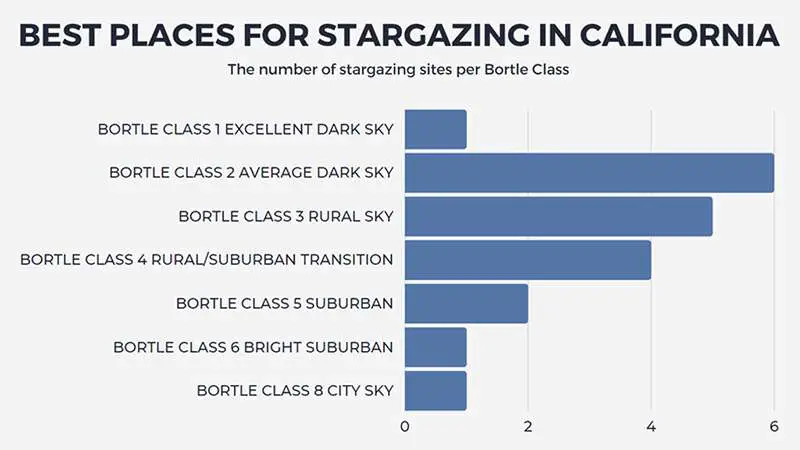
I’ve used the Bortle Dark-Sky Scale extensively, and I appreciate how it was developed by John Bortle to guide astronomers. It is based on nearly 50 years of observation experience to describe the amount of light pollution in a night sky. The Bortle Scale is a nine-level numeric scale that measures the night sky’s brightness in a particular location.

A Bortle Class 1 is an excellent dark-sky site. A Bortle Class 9 is an Inner-city sky. This is where the only objects to observe are the Moon, the planets, bright satellites, and a few of the brightest star clusters.
DARK SKY MAP CALIFORNIA

Now that you’re familiar with the Bortle Scale, let’s take a look at the California Light Pollution Map, which is a way of visualizing the Bortle Class across California (i.e., Bortle Map for California Stargazing).
In my quest for the perfect stargazing spot, I’ve found that dark skies areas, with their minimal light pollution, are truly ideal. The further away you are from big cities, the better your chances of finding a dark sky.
Now, let’s explore all the details of the best stargazing California has to offer.
1. ALABAMA HILLS
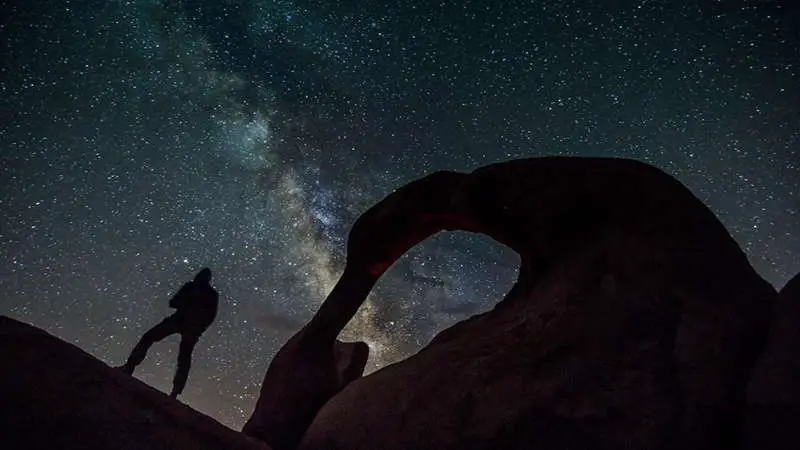
The Eastern Sierra has some of the darkest skies in California. A few miles west of Lone Pine is the Alabama Hills recreation area, which has a stunning view of Mt. Whitney. You can see this towering peak through a natural rock arch named the Mobius Arch.
No matter the season, The Alabama Hills offer a charming and different landscape to marvel at. In the fall, cottonwoods change color and in the winter, snow-capped mountains can be seen. As summer approaches, on a moonless night, you’ll easily be able to see the majestic Milky Way.
FREE STARGAZING CHECKLIST
My 5-page Stargazing Checklist will enhance your astronomical observations.
Follow this free checklist to navigate the night sky with confidence, clarity, and a sense of preparedness for a rewarding stargazing experience.

2. ANZA-BORREGO DESERT STATE PARK
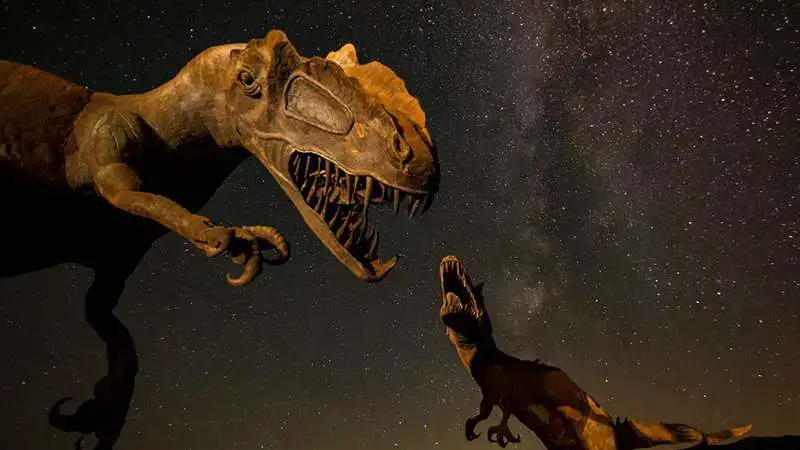
Anza-Borrego offers regular night sky programming to help you learn about the features of the night sky and the importance of darkness. Every month, the visitor center offers monthly stargazing and moon-watching programs. These give you a chance to learn more about saving dark skies.
Anza-Borrego Desert State Park is one of the most breathtaking places to go stargazing in California, and many would say it’s one of the best locations in the world!
You are lucky because the International Dark-Sky Association has classified it as an International Dark Sky Park. This means you’ll have an excellent chance of seeing a good night sky with plenty of colorful stars and distant galaxies. Anza-Borrego is the best Dark Sky Park California offers.
3. BENTON HOT SPRINGS
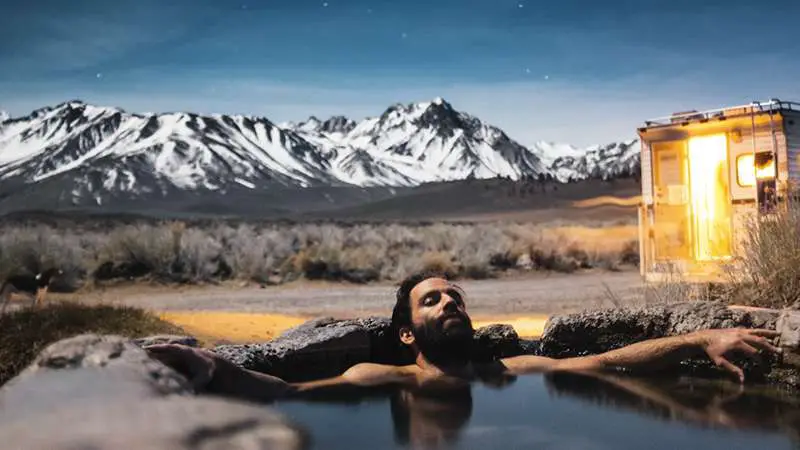
You’re lucky because Benton Hot Springs is one of the best places in the world for star-gazing.
This little hot springs town is located in the White Mountains, which is north and west of Reno, Nevada. For this reason, it’s one of the least light-polluted areas in America.
The Inn at Benton Hot Springs has campsites with outdoor hot tubs, so you’ll have the option to avoid going inside altogether.
4. BIG SUR
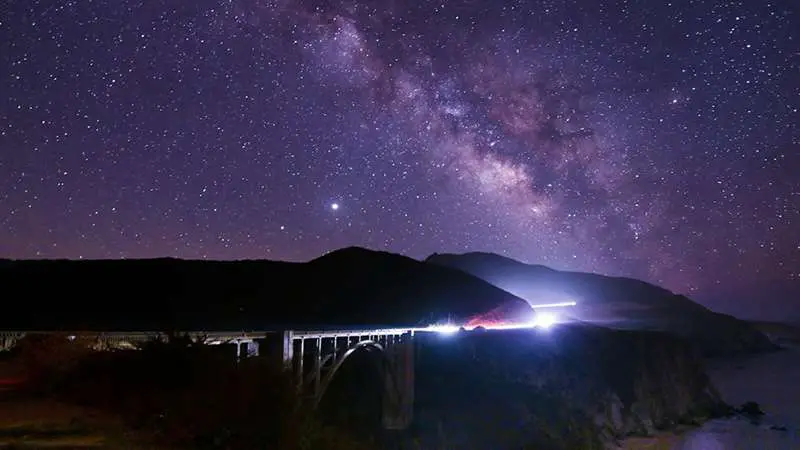
On my many visits to Big Sur, I’ve been captivated by some of the darkest, most star-filled skies in California. It stretches up and down the coast from Piedras Blancas State Marine Reserve to Limekiln State Park. Big Sur is where you can drive along the coast and take in the views of the stars above the ocean.
This region is perfect if you’re looking to escape contact with others and experience nature. The key to this amazing experience is to get just far enough away from the coastal area. This will help you avoid the dense fog that might cover the sky at night during your trip.
There are many Big Sur stargazing sites in the area, including Pfeiffer Big Sur State Park, Point Lobos State Natural Reserve, and Bixby Bridge. With a Bortle Scale Number of 2, you’ll easily be able to make out the complex structure of the Milky Way.
Big Sur is one of the best places to see the Milky Way when stargazing in the Bay Area.
5. BORREGO SPRINGS
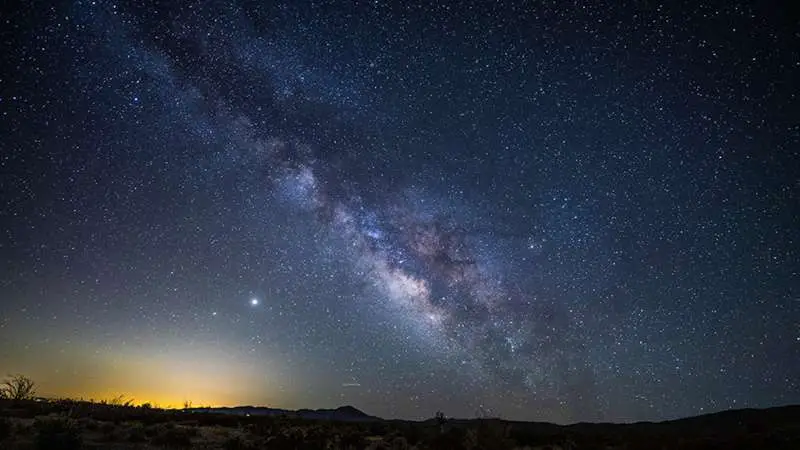
Borrego Springs was the first International Dark Sky Community in California! It earned that designation by taking measures to restrict and modify lights on public streets, outside of businesses, and even on residents’ front porches. Borrego Springs is the perfect place to stargaze.
You can use your telescope to enjoy the night sky or you may attend one of the special scheduled star parties led by an educator. Star parties feature dinner and drinks followed by presentations and guided stargazing.
For a list of all the international dark sky communities in the US, head over to DarkSky.org. Borrego Springs could easily be the darkest place in California.
6. COTTONWOOD CAMPGROUND: Joshua Tree National Park
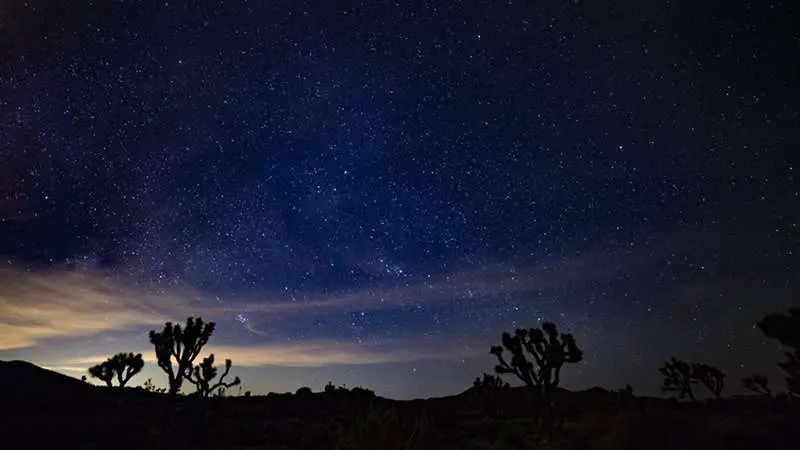
Joshua Tree National Park is arguably the best place to stargaze in California’s low desert. In fact, it’s such a good place I wrote a few articles all about it:
- Is Joshua Tree Free at Night?
- Is Joshua Tree Good For Stargazing?
- When Can I See the Milky Way in Joshua Tree?
- Can You Still See Stars with a Full Moon in Joshua Tree?
- Best Time To Go To Joshua Tree For Stargazing
Filled with spectacular views, astonishing desert ecosystems, and vast open lands, this national park is a true marvel that is worth the drive from Los Angeles. It’s probably the best place to see the stars in California.
The best time to visit is during the ranger-guided events happening at this popular destination! They’ll provide you with plenty of opportunities to enjoy the night sky. Cottonwood Campground Amphitheatre is where there usually are week-long events with high-powered telescopes in April. A complete list of events can be found on the park’s website.
7. GLACIER POINT: Yosemite National Park
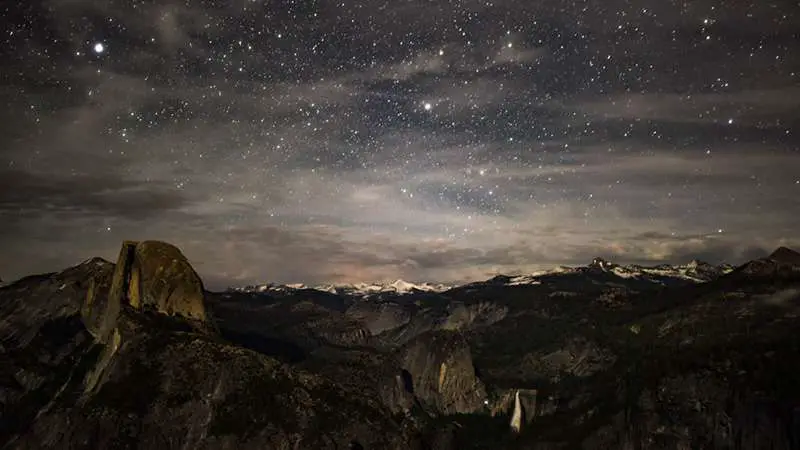
Looking for a great place to view the stars during summer? Check out Glacier Point. It’s located in Yosemite Park, miles away from any city lights. You’ll be able to see the sky as it was meant to be seen – very dark.
Bring along your star chart to look for constellations. Or, through binoculars, observe our planetary neighbors. Saturdays are often when amateur astronomers set up their telescopes at Glacier Point.
8. GRIFFITH OBSERVATORY
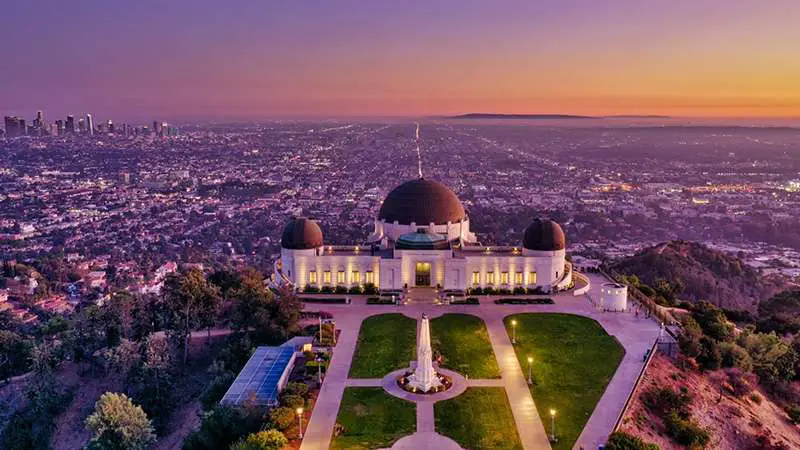
The Griffith Observatory is Southern California’s gateway to the cosmos! You can look through telescopes, explore exhibits, and enjoy spectacular views of Los Angeles. They offer a monthly Griffith Observatory Sky Report where you can read about what you can observe in Los Angeles.
The observatory is on the south side of Mount Hollywood, which is inside Griffith Park. Admission to the observatory and exhibits is free. Some shows have an entrance fee. The exhibits in the museum are very engaging and thought-provoking and you’ll get to see them for free just by walking through.
9. KELSO DUNES

The Kelso Dunes in the Mojave National Preserve are some of the most photographed sites in California’s high desert. Kelso Dunes has a lot to offer for daytime activities and nighttime stargazing. The dunes were built from sand blown by west winds from the Mojave River’s sink at Soda Lake.
The rolling dunes in the area are similar to those seen in Egypt’s Great Sand Desert. The area is full of awe-inspiring and quiet beauty, including lava beds. Virtually no airplanes fly over this location, which makes it the perfect spot for taking long-exposure photographs that capture detail at night, or for watching the Perseid meteor shower. The 45 square mile dunes rise 650 feet over their surroundings.
10. LAKE TAHOE
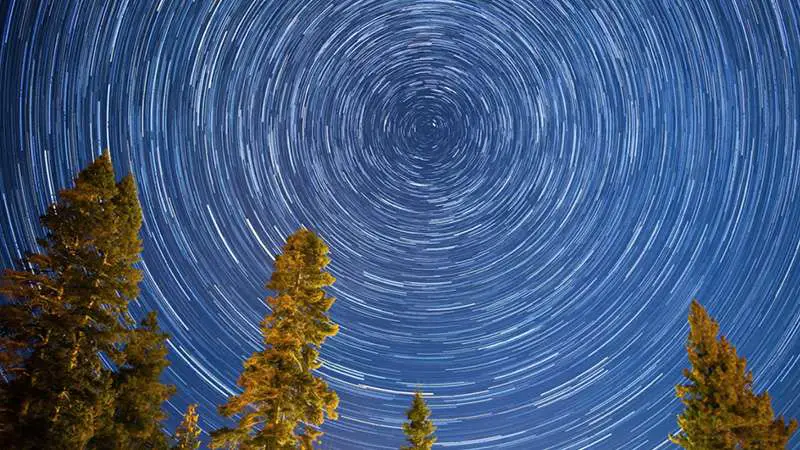
Lake Tahoe enjoys up to 300 clear nights each year. Dry air, combined with the western onshore marine airflow pattern, makes the region ideal for observatory-quality viewing of planets, stars, galaxies, and other celestial wonders. It also has low atmospheric turbulence, making it a prime destination for astrophotography.
Each beach in North Tahoe offers a unique experience. Sand Harbor faces south and is perfect for sunsets before the stars come out. Bring some grub for an evening filled with serene stargazing opportunities! Or head north to Secline Beach to enjoy views of the entire lake and unobstructed starry skies, thanks to the nearby trees blocking much of the light pollution.
11. LICK OBSERVATORY

It’s incredible how the Lick Observatory was built without any paved roads. Everything was hauled up there in horse-drawn carts at the time! The first new moon of Jupiter to be identified since Galileo’s time was discovered at this observatory.
It is on the summit of Mount Hamilton, in the Diablo Range just east of San Jose. You are permitted to visit Lick Observatory at night by purchasing a ticket to the Summer Series from June through September. The Evenings with the Stars programs are held annually as part of their Summer Series.
Each year they bring world-renowned astronomers to the summit of Mount Hamilton for a night with the “stars” you won’t forget! To be sure the sky will be clear for you, head over to their Clear Sky Chart. It is an astronomer’s forecast, predicting when Mount Hamilton will have good weather for astronomical observation.
12. LITTLE RIVER INN STARGAZING PACKAGE
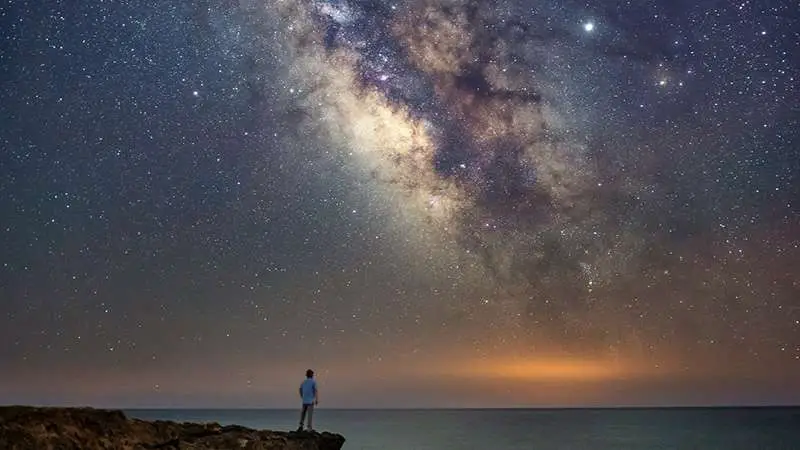
The Little River Inn is situated at sea level on the Mendocino Coast, just north of Sonoma County. This Victorian inn with cottages features a 9-hole golf course, a driving range, and a putting green. Additional amenities include tennis courts, a day spa, a charming restaurant and bar, and complimentary parking.
Their Stargazing Package for two includes:
- Two-night stay in an ocean-view room
- A stargazing kit, consisting of special binoculars, a star map, a star guide, and a flashlight
- A travel blanket, hot chocolate, and 2 bags of popcorn
To make a reservation, call 707.937.5942 or 888.INN.LOVE.
13. MALIBU CREEK STATE PARK
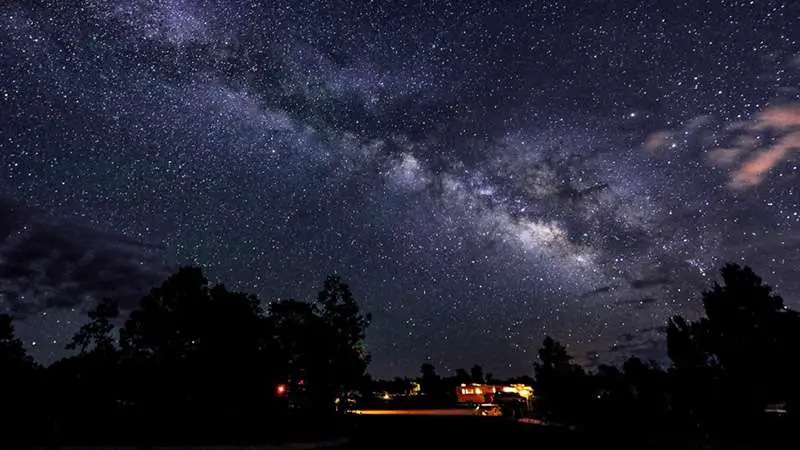
Malibu Creek State Park is located just 25 miles away from downtown Los Angeles. It’s named “The Yosemite of Southern California” due to its amazing natural beauty. The 360-degree views of the dark sky are spectacular.
Malibu Creek State Park stargazing is not to be missed. It’s one of the best places to see stars in southern California.
After a pink and gold Santa Monica Mountains sunset, you can watch the night deepen around the hillsides. The park closes at 10 pm, but there are many parking spots from which you will find a good vantage point in any parking lot.
14. MESQUITE FLAT SAND DUNES: Death Valley National Park
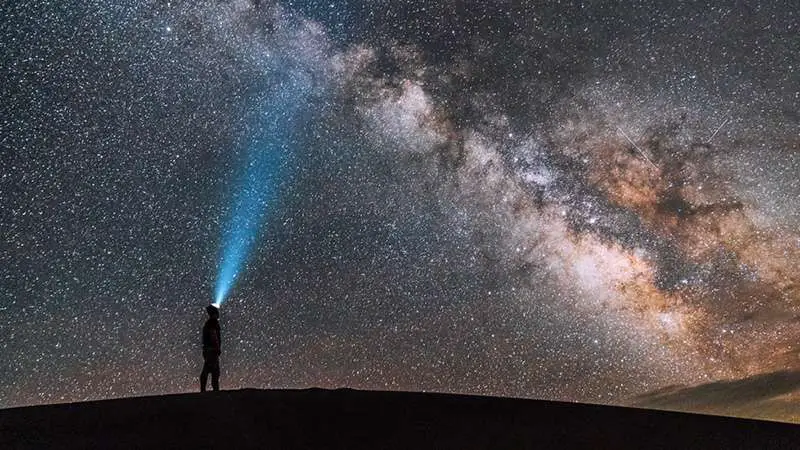
Mesquite Flat Sand Dunes, in Death Valley National Park, is a photographer’s dream. Be sure to catch the dunes during sunset or sunrise. With its vast open spaces and lack of artificial light, you’ll be able to see a clear night sky full of stars.
You might see the strange phenomenon known as “gegenschein,” a brightening of the sky opposite the Sun. The planets and the Milky Way will seem annoyingly bright! Also, the coyotes will perform for you throughout the night.
This place is a must on your stargazing bucket list; it’s perfect.
15. MIDLAND

If you’re looking for an all-inclusive desert camping experience, this Midland ghost town is the place to go, even during daylight hours.
With plenty of campsites and dark skies, it’s the perfect spot to stargaze in Southern California. Detox from the city at this old mining town. I promise it will be worth your while. The Colorado River Astronomy Club holds popular meetups at this location.
16. MOUNT DIABLO STATE PARK

Mt. Diablo is the highest public observatory in the Bay Area. If you’re looking for Bay Area stargazing, Mount Diablo is a good place to go. They have a public observatory that has unobstructed views of the Bay Area. It’s one of the best places to stargaze in Northern California.
The Mount Diablo Observatory offers public stargazing programs through the Mount Diablo Observatory Association. On clear evenings, visitors to the observatory atop Mt. Diablo can enjoy a perfect night sky view.
These events are sponsored by Mt. Diablo State Park and its sister organization, Mount Diablo Astronomical Society, under the MDOA’s Public Astronomy Programs. This program is now in its 28th year!
17. MOUNT WILSON OBSERVATORY
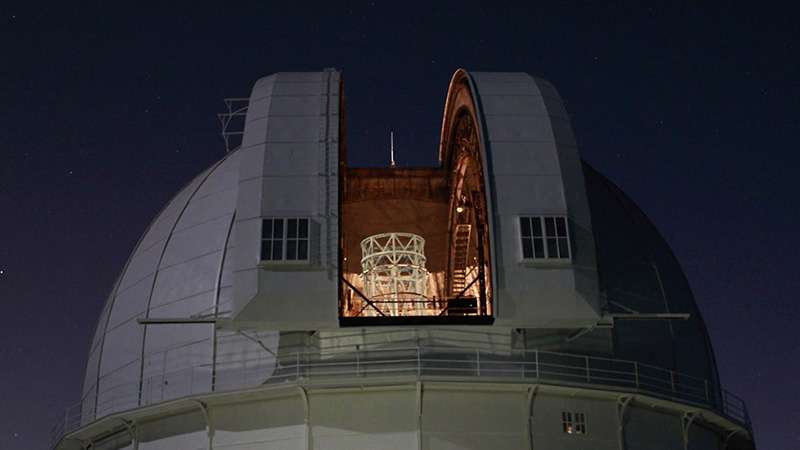
An inversion layer above Los Angeles prevents smog from filtering up high into the atmosphere. This phenomenon gives Mt. Wilson Observatory an unobstructed view of the night sky, despite being only about 33 miles away from Los Angeles. Mount Wilson Observatory and the Los Angeles Astronomical Society host occasional free public star parties at the observatory.
Dr. Edwin Hubble stepped foot on Mount Wilson Observatory in 1919, which is roughly around the time when the largest telescope in the world at that time was completed – the 100-inch Hooker Telescope. At that point, most astronomers widely believed that the Milky Way galaxy was the only thing in the universe.
Astronomy is something like the ministry.
No one should go into it without a call. I got that unmistakable call, and I know that even if I were second-rate or third-rate, it was astronomy that mattered.
Dr. Edwin Hubble
18. OBSERVER’S INN

If you’re looking for an escape into nature, the Observer’s Inn could be what you need. The Inn is located in the beautiful Julian Mountains in northeast San Diego County, close to the Cleveland National Forest.
best place to see stars in southern California
Read my article about Stargazing in Julian, home of the annual Starfest, and perhaps the best place to see stars in Southern California.

Join one of their star tours. They start with a laser-guided tour of the night sky under the stars and include a brief explanation of how telescopes work. The stargazing tour is filled with fascinating information about the stars and constellations. It will give you a new perspective on the universe.
19. PALOMAR OBSERVATORY: Palomar Mountain

Stargazing in San Diego would not be complete without a visit to Palomar Observatory. It’s arguably the best place to stargazing in San Diego.
The Explore the Stars Program takes place one weekend a month, from April through October, at the Observatory Campground in the Cleveland National Forest on Palomar Mountain.
Experienced amateur astronomers set up their telescopes for you to look at real-time images of breathtaking views of the universe. Saturday nights feature a free program at dusk by experts.
20. PIGEON POINT LIGHTHOUSE: The Top Spot Near San Francisco
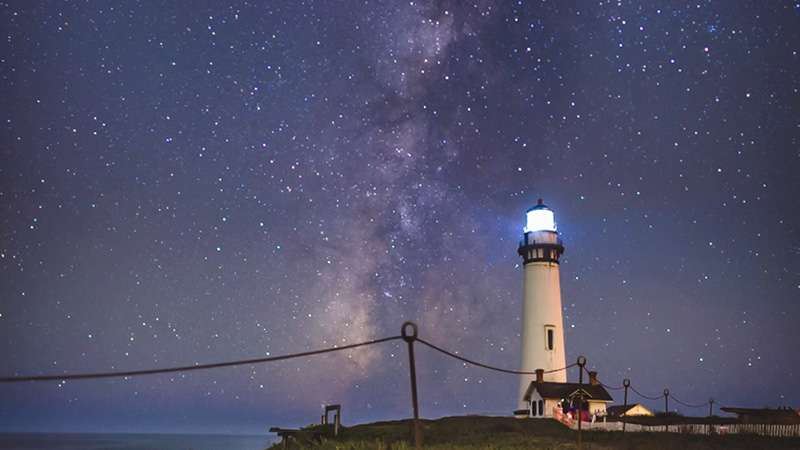
The special thing about Pigeon Point Lighthouse is that all of its outdoor lights face the ground, and all the bulbs inside and out are either amber, yellow, or red. This helps to reduce light pollution. It makes this a good place during the new moon for amateur astronomers, assuming of course you have clear skies.
Perched on a cliff on the central California coast, 50 miles south of San Francisco, the 115-foot Pigeon Point Lighthouse is one of the tallest lighthouses in America. It has been guiding mariners since 1872.
The Santa Cruz Astronomy Club holds stargazing parties at this location. Be sure to check with them to see if they’re planning any events for when you might be in the area.
21: RITZ-CARLTON, RANCHO MIRAGE: PALM SPRINGS
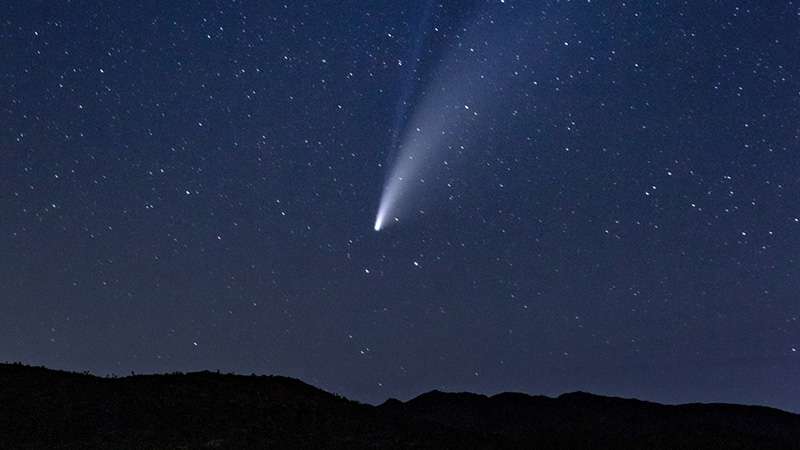
Palm Springs is not just for horseback riding. Here you can see the sky like never before! The Ritz-Carlton Rancho Mirage hosts Saturday Stargazing sessions using an 11-inch computerized telescope that creates stunning images and displays with a magnification power of up to 140 times larger than the naked eye.
You can get up close with different constellations and planets, including Saturn, Mars, Jupiter, Venus, Sirius, and the Orion Nebula. Year-round, you will experience moments of discovery as you view intricate details of the craters on the moon and discover what you may never have seen before.
22. SALTON SEA

Visitors to the Salton See California State Recreation Area won’t find that they’re limited to just day use: the park is open 24 hours a day. That means you don’t have to commit to camping to enjoy the night skies here.
Quiet spots can be found up and down the shore, some of them with concrete pads — a boon for those with tripod-mounted scopes. And best of all, the State Recreation Area is far enough from the bigger cities of Coachella and Imperial Valley, which means the skies here get very dark.
23. YOSEMITE VALLEY: Yosemite National Park

Yosemite National Park isn’t just one of the most beautiful places in the world, it’s also a great place for budding astronomers and curious night sky watchers to come. Any list about stargazing California wouldn’t be complete without mentioning Yosemite.
The remote location of this national monument protects some of the darkest night skies in the country. It allows you to easily see planets, stars, galaxies, and more!
Yosemite Valley, Tuolumne Meadows, and Wawona offer you astronomy walks or talks. The Milky Way core is visible in the northern hemisphere during the summer months. So if you plan your Yosemite Valley stargazing trip between April and October, you’ll have a good chance of seeing it.
Bonus: Templin Highway Stargazing Area

There’s one more spot in Southern California that I recently wrote an article about. It’s the Templin Highway Stargazing Area. This spot is just north of Los Angeles, in a class 4 Bortle Scale area. Read the article to learn more about this excellent star gazing California spot, close to L.A.
FREQUENTLY ASKED QUESTIONS
WHERE IS THE BEST PLACE TO SEE THE MILKY WAY IN CALIFORNIA?
Joshua Tree National Park is one of the darkest parks in Southern California, and it received the honor of being designated an International Dark-Sky Park by the IDA. This means that many visitors can view the Milky Way for the first time.
WHEN CAN YOU SEE MILKY WAY IN CALIFORNIA?
The Milky Way is visible on dark nights, but it’s only visible from March – July. It appears horizontal in the sky. Read my separate article about What Months Can You See the Milky Way in California.
IS THE MILKY WAY VISIBLE IN YOSEMITE?
Absolutely, but only from March through July. If you visit Glacier Point, you’ll be able to see many beautiful things in the night sky such as constellations, nebulae, and planets. Other than that, with a telescope, you might also be able to see celestial objects like galaxies and star clusters.
CAN I ENTER JOSHUA TREE AT NIGHT?
Yes, the park gates are open 24/7 year-round. Anyone can drive in or out of the park, no matter where they’re staying. Read my separate article that addresses Is Joshua Tree Free At Night? Joshua Tree is the best Dark Sky Reserve California offers.
CAN YOU SEE MILKY WAY WITH THE NAKED EYE?
The Milky Way is a hazy form of stars that the naked eye can easily detect. You can see it all year, no matter where you are in the world. Just as long as your sky is clear, and the light pollution is minimal, you’ll be able to see it.
WHAT IS THE BEST MONTH FOR STARGAZING?
Autumn, Winter, and Spring are the best times to stargaze. Many astronomers refer to this period of time as the ‘observing season’. You can start looking as early as October when clocks go back an hour (making nights longer). This will continue until March when clocks go forward an hour (making nights shorter).
HOW DO YOU KNOW IF IT’S A GOOD NIGHT FOR STARGAZING?
The best time for stargazing is when it’s dark enough to see without any natural light. Keep an eye out for a full moon, you’ll want to avoid this since there will be too much light in the sky. If there’s no moon, visibility should still be good and you might be able to see the Milky Way.
WHAT TIME SHOULD I GO STARGAZING?
If there is a moon visible in the sky, it will wash out the light from many stars or meteor showers. However, as the Earth rotates through the night and before sunrise, you’ll see new stars and planets start to become visible.
HOW LONG AFTER SUNSET DO YOU STARGAZE?
For the 48 contiguous states, it typically takes anywhere from 70 to 100 minutes for true darkness to arrive after sunset. The further South you are, the sooner it gets darker after sunset. Read my article on Stargazing after Moonset.
Where to see the milky way in California?
In California, you can witness the Milky Way‘s beauty in several exceptional locations. Notable spots include Joshua Tree National Park and Death Valley National Park, known for their dark, star-filled skies. The Eastern Sierra region around Bishop and Mammoth Lakes offers minimal light pollution, while Anza-Borrego Desert State Park provides a remote desert setting. Lastly, Big Sur’s coastal charm and Lassen Volcanic National Park’s volcanic landscapes also offer excellent Milky Way viewing opportunities.
TL;DR Best Places for Stargazing in California
- This article boasts 23 top-notch best places to see stars in California, each known for its dark skies and minimal light pollution.
- Understanding the Bortle Scale is key to finding the best locations for celestial observations in Dark Sky California.
- Light pollution maps are essential tools for identifying ideal stargazing spots across the state.
- Designated Dark Sky Parks offer the clearest views of the night sky, free from urban light interference.
- Personal experiences and a stargazing checklist enhance the astronomical observation journey for enthusiasts.
Your curiosity fuels our shared journey under the stars. Whether you have questions, insights, or a starlit story to share, I’m here to engage with your perspective. Let’s connect in the comments below.
Read my other articles in my Best Stargazing in US series:
- Best stargazing in Arizona
- Best stargazing in Colorado
- Best stargazing in Florida
- Best Hawaii Stargazing, especially on the Hawaiian Islands of Kauai, Oahu, and Maui
- Maine Stargazing
- Nevada Stargazing
- New Mexico Stargazing
- New York Stargazing
- Best stargazing in North Carolina
- Best stargazing in Ohio
- Best stargazing in Oklahoma
- Best stargazing in Oregon
- Best stargazing in Pennsylvania
- Best stargazing in Texas
- Best stargazing in Utah




